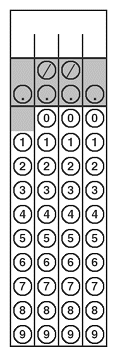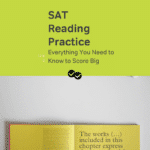
Want to know what you’re going to see when you take the SAT? I’m going to break down exactly how many of each kind of question there’ll be on your test so you know what to expect and what to practice most. Make sure to follow some of the links in this post to get a better idea of what these question types actually look like. Let’s divide them up by the SAT’s main topics.
SAT Question Types – Math
There are a total of 58 math questions on the SAT Math Test: 20 in the “No Calculator” Math section, and 38 on the portion of SAT Math where you can use a calculator. There are two general types of math questions, multiple-choice and grid-in.
Multiple-choice: 45 math questions give you possible answers, so you’ll have lots and lots of chances to use process of elimination.
Grid-in questions: There are a total of 13 grid-in questions between the two sections of math on the SAT. You come up with the answer on your own and bubble it in:
There are a ton of different categories you could use to break down the SAT’s math questions, but it’s a bit tricky since many more difficult questions will involve more than one skill. Officially, the College Board breaks it down into four categories:
- Heart of Algebra, 19 questions
(linear equations, systems of linear equations, and inequalities) - Problem Solving and Data Analysis, 17 questions
(ratios, proportions, percentages, units, quantitative data, probabilities) - Passport to Advanced Math, 16 questions
(equivalent algebraic expressions, quadratic equations, exponential functions, other nonlinear equations and functions) - Additional Topics in Math, 6 questions
(basic trigonometry, the geometry of area, volume, lines, angles, shapes)
But that’s not the whole story. We’ll go more into detail about how well-represented various skills are in another post. For now, just know what’s not tested (advanced trigonometry and calculus, for example) and what’s very important (hint hint: Algebra).
SAT Question Types – Reading
All questions on the SAT Reading Test are based on passages that are 500-750 words in length, and there are a total of five passages on the exam. One passage will be a “dual passage,” two paired readings that cover the same subject. The questions that follow each passage can be divided into three broad categories: command-of-evidence questions, words-in-context questions, and text-analysis questions. The Reading section has 52 questions in total, all of which are multiple-choice.
- Command of Evidence, 10 questions
These questions focus on evidence-based inferences and the ways that authors use (or don’t use) evidence to support their claims. - Words in Context, 10 questions
These questions ask about the meaning and use of vocabulary in the context of the passages. - Analysis, 32 questions
Analysis questions ask test-takers to evaluate author attitude and purpose, passage structure and organization, and other “deeper” aspects of each piece of writing. Note that command-of-evidence and words-in-context questions can sometimes also have an analysis component.
Learn more about the SAT Reading section here.
SAT Question Types – Writing
The SAT Writing and Language Test consists of 44 multiple-choice questions. There are really just two types of questions: expression-of-idea questions and questions that test your understanding of standard writing conventions in English.
- Expression of Ideas, 24 questions
(organizing content, adding relevant information, removing irrelevant information, setting the correct tone) - Standard English Conventions, 20 questions
(grammar, punctuation, mechanics, word choice, phrase structure)
SAT Question Types – The Optional Essay Section
On the SAT, the Essay Section is optional but may be added to the exam for a small extra fee ($11.50). All essay questions have the same format: a piece of editorial writing is given to the test-taker, who must then compose an analysis of the author’s argument.
Practice every SAT question
By the time you take the test, you’ll want to have practiced every type of SAT question extensively. That means doing a lot of practice questions (like those found on Magoosh!).
And don’t forget to take some full-length SAT practice tests too!
This post was updated with contributions from Magoosh test prep expert David Recine.
All Magoosh SAT prep plans are digital SAT ready! Start studying today.







Leave a Reply